| In my last article I covered some
of the physical properties of light. The purpose of this article
is to discuss the factors that affect the quantity (irradiance
or light intensity) and quality (color or spectra) of light
reaching organisms living in the ocean, predominately those
that live on coral reefs. It is useful for us to have some understanding
of the characteristics of light in the underwater realm, especially
when considering the requirements of the organisms we keep.
Sunlight is modified by a number of factors
from the time it hits the Earth's atmosphere until it reaches
organisms living underwater on a reef. Even before it reaches
the ocean surface, sunlight is modified due to the Earth's
orientation and by the atmosphere. The ocean surface itself
can affect the penetration of sunlight and various factors
in the water itself, such as depth and turbidity, can influence
the intensity and spectrum of light.
Before I discuss these influences, I feel
it is important to note that while our vision is sensitive
to various intensities and spectra of light, it is not very
good at judging either intensity or color in isolation. Our
eyes adjust to a huge range of intensities, over a number
of orders of magnitude, but it is not easy for us to estimate
the intensity with our eyes alone. Similarly, our brains interpret
images we see and may adjust the perceived colors such that
we may be unaware of a color shift. For example, when I walk
into a room lit by incandescent lamps, I rarely notice that
everything has a red or yellow shift due to the spectrum output
by the lamps. Therefore, the influences discussed in this
article may not be obvious to our eyes. For example, when
diving, the attenuation of light with depth may not be noticeable
until a depth of 15 or 20m is reached.
Celestial and Atmospheric Effects to Lighting
Solar radiation that reaches the outside
of the Earth's atmosphere is fairly constant. It is worth
noting that the orbit of the Earth around the Sun is such
that the distance between the two is not always constant.
The Earth is at its closest to the Sun (147.5 million kilometers)
in early January, and at its furthest (152.5 million kilometers)
in early July. This will only have a very slight impact (<5%)
on light intensity.
Solar radiation is made up of far more
than just visual light (~400-700nm) and includes shorter wavelengths
(ultraviolet) and longer wavelengths (infrared).
Despite the near constant amount of solar
radiation hitting the atmosphere, the amount that reaches
the surface of the oceans varies considerably based on seasons,
latitude, and time of day. This is largely due to the angle
at which light from the Sun strikes the Earth. If the Sun
is perpendicular to the ocean surface, the light is spread
over a relatively small area. As the angle of the Sun decreases,
the same amount of light will be spread over an increasingly
wider area, reducing the intensity at any one point. Figure
1 shows this relationship.
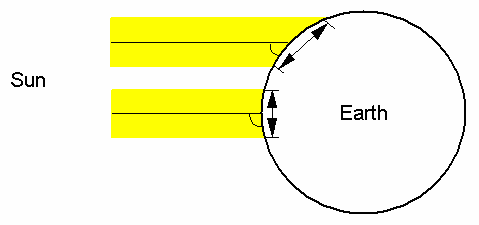 |
|
Figure 1: A "beam"
of sunlight that hits the Earth perpendicular to the
ocean surface is spread over a smaller area than a "beam"
hitting the ocean at a more acute angle relative to
an ideal horizon.
|
As light passes through the atmosphere,
it is by both scattered and absorbed and these processes reduce
the amount of light reaching the ocean surface. Scattering
occurs mainly due to air molecules and aerosols, and absorption
is largely due to ozone, water vapor, oxygen and carbon dioxide
(Alados-Arboledas et al. 2000). The scattering and absorption
act differently on different wavelengths, so the quality or
color of light is also affected. The greater the distance
of atmosphere through which the light passes, the greater
the effect; conversely, the shorter the distance, the greater
the transmittance. When sunlight passes through the atmosphere
at an angle perpendicular to the ocean surface, it will travel
through less atmosphere than when it travels through the atmosphere
at an angle, as shown in Figure 2.
 |
|
Figure 2: A "beam"
of sunlight that is perpendicular to the Earth passes
through less atmosphere than a "beam" at a
more acute angle relative to an ideal horizon. The blue
line shows the depth of atmosphere through which the
light must pass.
|
The combined effect of the spreading, scattering,
and absorption is a variation of illumination with solar elevation.
An example of the variation in illumination with solar elevation
is shown in Figure 3.
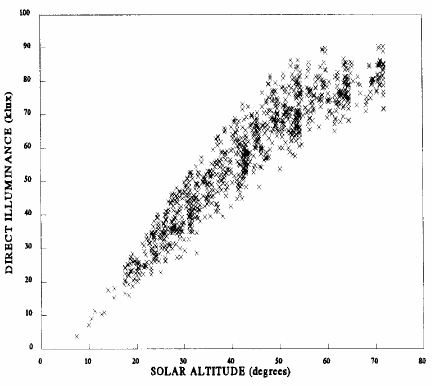 |
|
Figure 3: Direct illuminance
variation with the solar altitude for clear skies (Robledo
and Soler, 2000).
|
Not all wavelengths of solar radiation
penetrate the Earth's atmosphere to the same degree. Shortwave
ultraviolet radiation below around 290nm (UV-C) does not penetrate
the ozone layer in the outer atmosphere (Odum, 1971). Thinning
of the ozone layer may lead to greater transmittance of UV-C
which is lethal to organisms. Infrared radiation (700-10,000nm)
is irregularly attenuated due to absorption by the atmosphere
(Odum, 1971).
Seasons, latitude, and time of day all
affect the angle between the ocean surface and the Sun. Between
sunrise and sunset, the angle of the Sun increases from an
angle of zero degrees at sunrise to its highest point at around
noon, and then decreases to zero degrees at sunset. Figures
4 and 5 show the hourly solar elevations for two tropical
locations at three different times of the year.
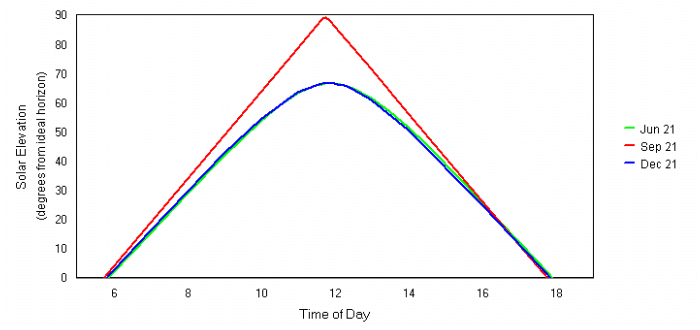 |
|
Figure 4: Solar elevation over
the course of three days for a location on the Equator
(Data from Geoscience Australia: National Mapping Division).
|
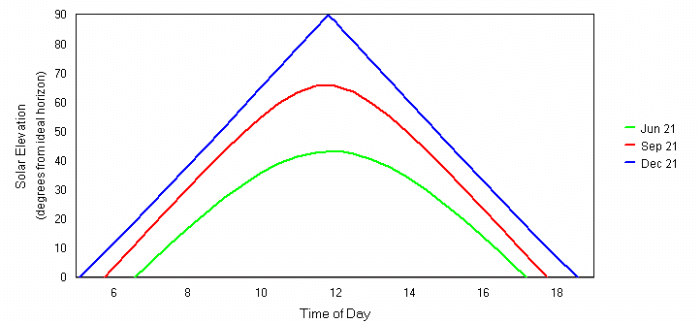 |
|
Figure 5: Solar elevation
over the course of three days for a Heron Island, Great
Barrier Reef (23º26' S) (Data from Geoscience Australia:
National Mapping Division).
|
The highest point of the Sun on any given
day is determined by a combination of latitude and season.
The Earth's axis is inclined by 23º30' in relation to
the Sun, and this means that the northern hemisphere is tilted
towards the Sun in late June and tilted away from the Sun
in late December. At "true noon"* on the Tropic
of Cancer (23º30'N) on the Summer solstice (June 21/21),
the Sun is at 90º to the ocean surface. The same condition
occurs at noon on the Tropic of Capricorn (23º30'S) on
December 21/22, on the equator (0º) on both equinoxes
(March 21/22 and September 22/23) and at other latitudes in
the tropics at two days per year on, before, and after the
Summer solstice. Outside the tropics, the Sun will never be
at an elevation of 90º. Figure 6 shows the maximum elevations
for three tropical locations over the course of a year.
* By "true noon" I mean the time of day when the
Sun reaches its highest point (zenith); this may or may not
coincide with noon local time.
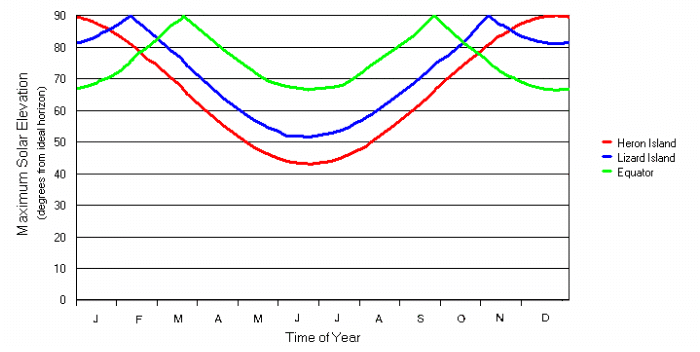 |
|
Figure 6: Annual cycle of maximum
solar elevation for three locations, Heron Island, GBR
(23º26' S); Lizard Island, GBR (14º40' S)
and a location on the Equator (Data from Geoscience
Australia: National Mapping Division).
|
Whilst the elevation of the Sun determines
the maximum possible intensity, atmospheric conditions such
as cloud cover and haze may directly reduce the amount of
light hitting the ocean surface. Cloud cover and generally
humid conditions are quite common in the tropical locations
of reef systems, and tropical storms are a common occurrence
during the summer months. Clouds affect both the quantity
and quality of light reaching the ocean surface by reflecting,
absorbing, and transmitting the incoming solar radiation.
The loss of intensity will vary depending on the thickness
and type of cloud cover, and it is difficult to quantify the
effect. Cloud cover attenuates shorter wavelengths (UV, violet,
blue and green) almost equally, but causes greater attenuation
of longer wavelengths (yellow, orange, red and infrared) (Odum,
1971).
Figure 7 shows readings for irradiance
over the course of a single day at One Tree Island, Great
Barrier Reef. The irradiance curve is not smooth due to the
effect of atmospheric conditions such as cloud cover and haze.
The irradiance curve can be compared to the solar elevation
for the same day. The differences in the curves are largely
due to atmospheric conditions.
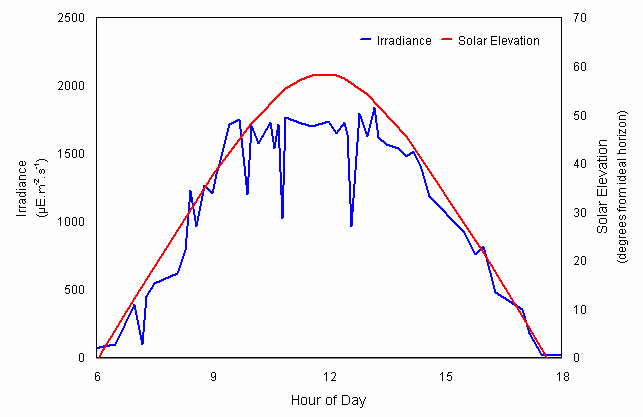 |
|
Figure 7: Irradiance and solar
elevation for September 2, 1998 at One Tree Island,
Great Barrier Reef (23°30'S, 152°06'E) (A. Salih,
unpublished data).
|
Latitude and time of the year also affect
the length of the day; that is, the number of hours between
sunrise and sunset. The days are longest at the same time
of the year when the sun reaches its highest maximum elevation.
Interestingly, locations on the equator have a nearly constant
day length of just over 12 hours. Figure 8 shows the annual
cycle of day length from three tropical locations.
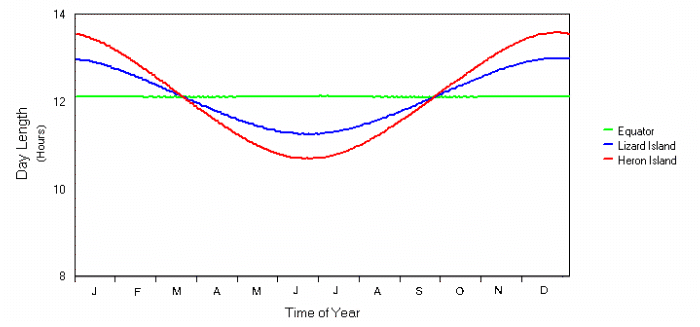 |
|
Figure 8: Annual cycle of day
length from three locations, Heron Island, GBR (23º26'
S); Lizard Island, GBR (14º40' S) and a location
on the Equator (Data from Geoscience Australia: National
Mapping Division).
|
The long term effects of hourly and seasonal
variations in irradiance, day length and atmospheric conditions
results in a annual cycle of the amount of light reaching
the ocean surface. The differences in the mean and the total
irradiance striking the ocean surface over different times
of a year can be significant. Figure 9 shows the variation
in mean monthly irradiance over 6 years.
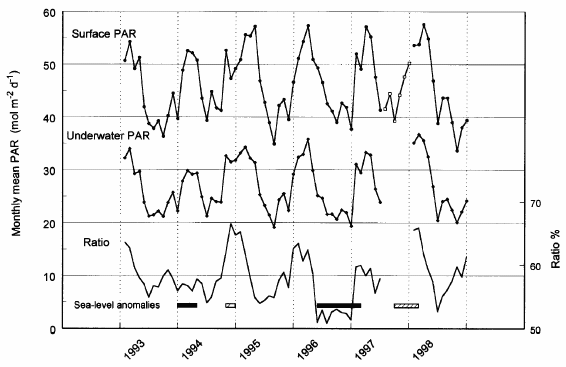 |
|
Figure 9: Monthly means of
photosynthetically available radiation (PAR) at the
surface (Surface PAR) and underwater (Underwater PAR)
near Ko Phuket, Thailand (7°53'N, 98°24'E) (Dunne
and Brown, 2001).
|
Effects of the Air-Water Interface
When light hits the water surface, some
light penetrates, but some light is reflected. The amount
of light that is reflected is greater when the angle between
the light rays and the water surface is small. When light
is coming from a point source, such as the Sun, the percentage
of reflectance can be determined using Fresnel's law (Weinberg,
1976). Figure 10 shows the theoretical reflection of sunlight
based on the elevation of the Sun. However, Fresnel's law
assumes an optically flat water surface which would be rare
for the ocean surface, and so actual reflectance may be greater.
Figure 10 also includes measured values of reflectance for
both smooth and rough water surfaces.
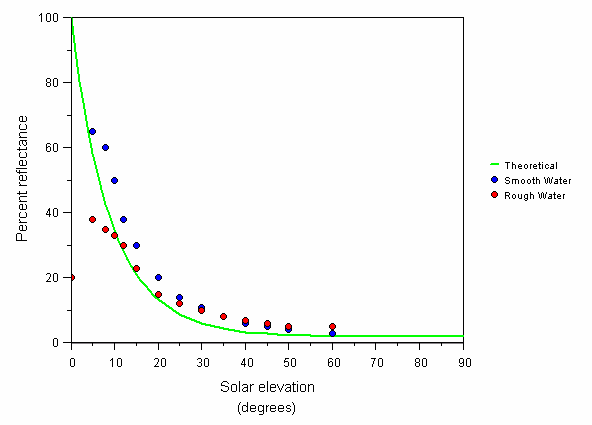 |
|
Figure 10: Reflectance of sunlight
in relation to solar radiation. Theoretical and measured
percentage of sunlight reflected off a completely smooth
water surface in relation to solar elevation (based
on calculations in Weinberg, 1976; Grichenko in Weinberg,
1976).
|
When the celestial and atmospheric effects
are considered with reflectance, solar elevation has a significant
effect on the amount of light penetrating the ocean surface.
While sunrise will bring some light to the submarine organisms,
the amount of light reaching the organisms will not be significant
until the solar elevation is at least 10º or even higher.
Effect of Depth
Light penetrating the water surface is
absorbed and scattered by the water molecules, plus suspended
and dissolved particles. Even very clear water attenuates
light at a significant rate. Even in very clear water less
than one tenth of the light that penetrates the water surface
still remains at a depth of 30m (Dustan, 1982), and in less
clear water, 90% attenuation may occur at shallower depths,
such as 15m on an inshore reef (Fabricius and Alderslade,
2001). Figure 11 shows measured irradiance at various depths.
Note that the irradiance scale is logarithmic. Figure 12 shows
irradiance attenuation as a percentage for different depths
on different reefs. Additionally, different wavelengths of
light are attenuated at different rates. In clear waters,
blue light between 440 and 490nm is attenuated the least,
while orange and red light (590 to 700nm) is attenuated the
most. In coastal waters, more blue light is absorbed due to
more suspended matter and phytoplankton in the water, and
green light penetrates the furthest. Figure 13 gives examples
of the irradiance of various wavelengths at different depths.
 |
|
Figure 11: Irradiance versus
depth for an "average sunny day" on Dancing
Lady Reef, Jamaica between February and April, 1978
(Dustan, 1982).
|
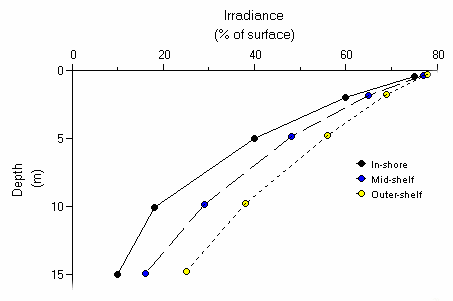 |
|
Figure 12: Light profile measured
on 17 inner-, mid- and outer-shelf reefs on the central
Great Barrier Reef (Fabricius and Alderslade, 2001).
|
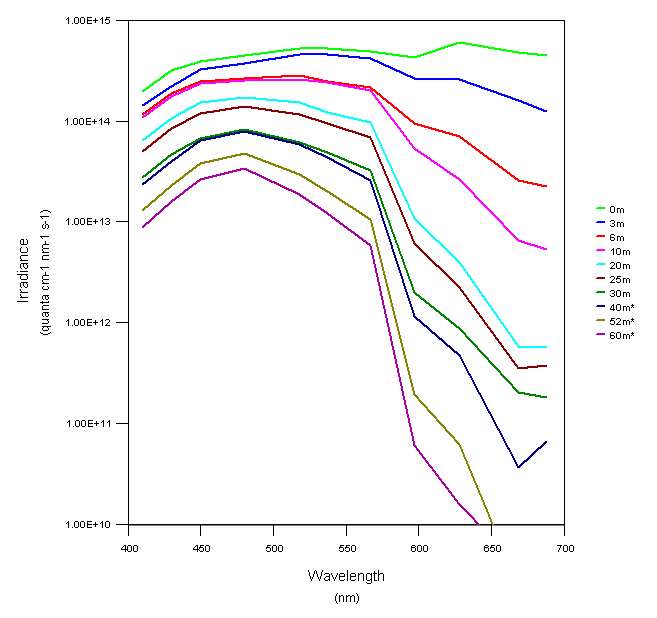 |
|
Figure 13: Spectral Irradiance
versus depth for an "average sunny day" on
Dancing Lady Reef, Jamaica between February and April,
1978 (Dustan, 1982). * 40, 52, and 60m are calculated
values.
|
Infrared radiation is rapidly absorbed
and does not penetrate into the water to any appreciable degree
(Falkowski et al. 1990). UV-B (290-320nm) appears to be attenuated
quite rapidly, but UV-A (320-400nm) can penetrate to depths
over 100m, with attenuation rates similar to light in the
range 425-560nm (Schlichter et al. 1986).
Other Factors Affecting Quantity and Quality
of Light
A number of other factors may affect the
quantity and quality of light reaching reef organisms. Turbid
water can significantly increase both absorption and scattering,
generally resulting in less transmitted light. The turbidity
may come from rough weather stirring up sediment or coastal
runoff. Additionally, turbid water differentially affects
the wavelengths of light that are absorbed and scattered,
changing the spectra of available light at different depths,
with more blue light being absorbed as previously mentioned.
Plankton blooms may also affect the transmittance of light.
Sessile organisms may be attached to substrates
at various angles. Horizontally oriented surfaces receive
more light than surfaces on an angle, and vertical surfaces
may receive only 25% of the light that is available to a horizontal
surface (Falkowski et al. 1990). The orientation of the organism
alters the amount of light received because much of the underwater
light is directional and penetration is mostly vertical. The
directional nature increases with depth. When the light hits
an angled or vertical surface, the same amount of light (that
would have hit a horizontal surface) is spread over a greater
area, reducing the intensity.
Sessile organisms may be in shaded situations
and this reduces the light they receive. The shading may come
from other sessile organisms growing above them, or from fixed
caves or shelves in the underwater terrain. In shallower water,
where the direction of the light may be more influenced by
the elevation of the sun, the amount of shading on a sessile
organism may vary throughout the day or year.
In shallow water, surface water movement
such as waves can act like a lens, focusing the light from
the Sun and resulting in flashes of light at more than twice
the intensity of light transmitted through a smooth surface
(Falkowski et al. 1990).
Summary
I have shown the great number of influences
on the intensity and spectra of light reaching underwater
organisms. While it is not necessary to understand the nature
of all these influences, it is useful to realize how variable
the underwater lighting regime can be. The location (both
latitude and depth) of an organism will determine the maximum
intensity the organism can receive; however, at any particular
time of day or from day to day, month to month, both the intensity
and spectrum of light an organism receives varies greatly.
Knowing the latitude and depth from
where a light requiring organism was collected would go a
long way towards providing information about the lighting
requirements for that organism. While this information is
generally not available for the collected organisms we keep,
it would only provide part of the picture, and as most photosynthetic
organisms are photoadaptive (the subject of a future article),
the precise intensity values are not needed.
|

